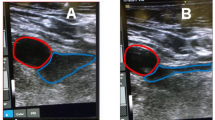Abstract
Purpose
The miniaturized transcatheter pacing system (TPS) implant is performed using a 27 Fr sheath. Achieving femoral vein access hemostasis after sheath removal is of utmost importance. Feasibility and clinical effectiveness of double device-based suture-mediated closure technique (DualPerclose) were evaluated.
Methods
Patients undergoing TPS positioning and treated with DualPerclose technique at our institution were considered. Feasibility of the DualPerclose technique included the rates of effective initial device suture fixation and effective hemostasis after sheath removal. Clinical efficacy considered intraprocedural and periprocedural bleeding events as well as midterm access site vascular injury assessed at 3 months using lower limb vascular ultrasonography. Data on all follow-up major adverse events were also collected.
Results
All patients (n = 83 patients; mean age 82.3 ± 7.1 years, 67.5% male gender, 85.5%, with structural heart disease, mean left ventricular ejection fraction 54.0 ± 9.6%, renal impairment in 31.3%) who underwent TPS positioning between November 2015 and February 2020 were considered. TPS positioning was successful in all patients. In 82 patients, the DualPerclose approach was utilized: 13 patients (15.8%) required > 2 devices to obtain effective fixing of 2 sutures; complete immediate hemostasis was achieved in 80 patients (97.6%). One (1.2%) severe groin-related bleeding event occurred. At midterm, 1 (1.2%) mildly symptomatic arteriovenous fistula was diagnosed (conservative treatment). Over a median follow-up of 22 (IQR 10–35.5) months, 14 (17.1%) major adverse events were recorded, including 1 loss of capture requiring TPS replacement and 5 deaths.
Conclusion
Femoral vein access closure using dual Perclose Proglide devices during TPS is feasible and clinically effective.


Similar content being viewed by others

References
Aytemir K, Canpolat U, Yorgun H, Evranos B, Kaya EB, Şahiner ML, Özer N. Usefulness of ‘figure-of-eight’ suture to achieve haemostasis after removal of 15-french calibre femoral venous sheath in patients undergoing cryoablation. Europace. 2016;18:1545–50.
Traullé S, Kubala M, Doucy A, Quenum S, Hermida JS. Feasibility and safety of temporary subcutaneous venous figure-of-eight suture to achieve haemostasis after ablation of atrial fibrillation. Europace. 2016;18:815–9.
El-Chami MF, Al-Samadi F, Clementy N, Garweg C, Martinez-Sande JL, Piccini JP, Iacopino S, Lloyd M, Viñolas Prat X, Jacobsen MD, Ritter P, Johansen JB, Tondo C, Liu F, Fagan DH, Eakley AK, Roberts PR. Updated performance of the Micra transcatheter pacemaker in the real-world setting: a comparison to the investigational study and a transvenous historical control. Heart Rhythm. 2018;15:1800–7.
Valiton V, Graf D, Pruvot E, Carroz P, Fromer M, Bisch L, Tran VN, Cook S, Scharf C, Burri H. Leadless pacing using the transcatheter pacing system (Micra TPS) in the real world: initial Swiss experience from the Romandie region. Europace. 2019;21:275–80.
Kodama A, Yamamoto M, Shimura T, Kagase A, Koyama Y, Tada N, Takagi K, Araki M, Yamanaka F, Shirai S, Watanabe Y, Hayashida K. Comparative data of single versus double proglide vascular preclose technique after percutaneous transfemoral transcatheter aortic valve implantation from the optimized catheter valvular intervention (OCEAN-TAVI) Japanese multicenter registry. Catheter Cardiovasc Interv. 2017;90:E55–62.
Bazarbashi N, Ahuja K, Gad MM, Sammour YM, Kaur M, Karrthik A, Saad AM, Khubber S, Dhaliwal K, Mick SL, Navia JL, Puri R, Reed GW, Krishnaswamy A, Kapadia SR. The utilization of single versus double Perclose devices for transfemoral aortic valve replacement access site closure: insights from Cleveland Clinic Aortic Valve Center. Catheter Cardiovasc Interv. 2019.
Rüter K, Puls M, von der Ehe K, Tichelbäcker T, Sobisiak B, Beuthner BE, Hünlich M, Schillinger W. Preclosure of femoral vein access site with the suture-mediated Proglide device during MitraClip implantation. J Invasive Cardiol. 2013;25:508–10.
Geis NA, Pleger ST, Chorianopoulos E, Müller OJ, Katus HA, Bekeredjian R. Feasibility and clinical benefit of a suture-mediated closure device for femoral vein access after percutaneous edge-to-edge mitral valve repair. EuroIntervention. 2015;10:1346–53.
Steppich B, Stegmüller F, Rumpf PM, Pache J, Sonne C, Lesevic H, Braun D, Hausleiter J, Kasel AM, Ott I. Vascular complications after percutaneous mitral valve repair and venous access closure using suture or closure device. J Interv Cardiol. 2018;31:223–9.
Steffel J, Verhamme P, Potpara TS, Albaladejo P, Antz M, Desteghe L, Haeusler KG, Oldgren J, Reinecke H, Roldan-Schilling V, Rowell N, Sinnaeve P, Collins R, Camm AJ, Heidbüchel H, ESC Scientific Document Group. The 2018 European heart rhythm association practical guide on the use of non-vitamin K antagonist oral anticoagulants in patients with atrial fibrillation. Europace. 2018;20:1231–42.
Ritter P, Duray GZ, Steinwender C, Soejima K, Omar R, Mont L, Boersma LV, Knops RE, Chinitz L, Zhang S, Narasimhan C, Hummel J, Lloyd M, Simmers TA, Voigt A, Laager V, Stromberg K, Bonner MD, Sheldon TJ, Reynolds D, MicraTranscatheter Pacing Study Group. Early performance of a miniaturized leadless cardiac pacemaker: the Micra transcatheter pacing study. Eur Heart J. 2015;36:2510–9.
Regoli F, Araco M, Moccetti T, Caputo ML, Conte G, Auricchio A, Moccetti M. Potential clinical utility and feasibility of combined left atrial appendage closure and positioning of miniaturized pacemaker through a single right femoral vein access. Am J Cardiol. 2017;120:236–42.
Author information
Authors and Affiliations
Corresponding author
Ethics declarations
Conflict of interest
FR receives speaker fees from Medtronic and consultation fees from Daiichi Sankyo. Others: no disclosures.
Additional information
Publisher's Note
Springer Nature remains neutral with regard to jurisdictional claims in published maps and institutional affiliations.
Supplementary Information
Below is the link to the electronic supplementary material.
10840_2021_1102_MOESM1_ESM.pptx
Supplementary file1. Closure of the femoral vein access site with the double suture-mediated closure device technique (DualPerclose) during TPS positioning (PPTX 8681 KB)
Rights and permissions
About this article
Cite this article
Regoli, F., Roberto, M., Grazioli-Gauthier, L. et al. Feasibility and clinical efficacy of double suture-mediated closure device technique for hemostasis during positioning of miniaturized wireless pacemaker. J Interv Card Electrophysiol 64, 129–135 (2022). https://doi.org/10.1007/s10840-021-01102-y
Received:
Accepted:
Published:
Issue Date:
DOI: https://doi.org/10.1007/s10840-021-01102-y



